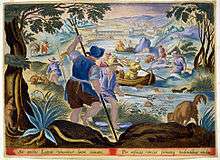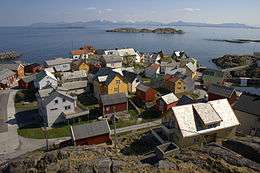Lamorna
Coordinates: 50°03′47″N 5°33′52″W / 50.06295°N 5.56440°W
Lamorna (Cornish: Nansmornow) is a village, valley and cove in west Cornwall, England, UK. It is on the Penwith peninsula approximately 4 miles (6.4 km) south of Penzance and lies within the Cornwall Area of Outstanding Natural Beauty (AONB); almost a third of Cornwall has AONB designation, with the same status and protection as a National Park.[1] The South West Coast Path passes through the cove.
Toponymy
First recorded as Nansmorno (in 1305), than Nansmurnou (1309), Nansmorne (1319), Nansmornou (1339), Nansmorna (1387) and Namorna (1388). Nans means valley plus possibly mor which is the sea.[2]
Geography
Lamorna Cove is at the southern end of a north-west to south-east valley. The cove is delineated by Carn Dhu (Black Rock) on the eastern side, Lamorna Point on the western side and Mount's Bay to seaward. The parish boundary runs through the stream with the civil parish of Paul on the western side and St Buryan to the east. The valley is privately owned from The Wink (public house) down to the cove, which is reached by a narrow lane to the car park and quay. The small village, half a mile inland, was originally known as Nantewas.[1][3]
History
The first record of tin streaming is in the 1380s when Alan Hoskyn was killed (murder was not proven) during a dispute, with Trewoofe, following the diversion of the stream. Mounds along the river are evidence of past activity.[3][4] Kemyel Mill was operated by the Hoskyn family from at least the 14th-century to the 1920s and is now a gift shop under different ownership.[3] There were two mills, one milled corn for animal feed, and the other flour.[4] Both mills are grade II listed buildings.[5][6]
In the 17th-century a privateer owned by the Penrose family was regularly moored in the cove and was wrecked during a storm. At one time five cannon were on the sea floor in 15 m (49 ft) and one is now at Stoney Cross, Leicestershire where it is used at an underwater archaeological training area. A number of silver coins found in 1984 and 1985 includes one dated 1653. The wreck is a popular diving site.[7]
The valley is now tree covered, but until around the 1950s the stream and hill side was grazed by cows, horses and pigs.[8] On the slopes, daffodils and early potatoes were grown with the flowers sent to markets at Covent Garden, Birmingham and Wales.[4]
Quarries
Waste tips on the eastern side of the cove are a reminder of the granite quarries first opened by John Freeman, on St Aubyn land, in 1849 and continued working until 1911.[9] Famous buildings and constructions include Admiralty Pier at Dover, London County Council offices, the Thames Embankment and Portland Breakwater. Stone from the cove was also used locally to build the Bishop Rock Lighthouse, Mousehole north pier and the Wolf Rock Lighthouse. Granite was dragged by chains to an iron pier, where the stream enters the sea, and transported by ship. A plinth weighing 20 tons was sent to The Great Exhibition of 1851 by sea but eventually, due to the hazards of loading ships, granite was sent by road via Kemyal and Paul Hill through Newlyn, to the cutting yards in Wherrytown. The present quay was built in the late 19th-century, possibly rebuilt on an older quay and is a grade II listed building.[10] A quarry on the west side of the cove failed due to the high quartz content of the granite.
The Lamorna Cove Hotel, built in the 1870s and known as Cliffe House, was originally the quarry manager's home, a school and chapel (with bell tower) for the quarry workers and their families. It was first used as an hotel in the 1920s.[4][9][11] During the Second World War the hotel was occupied by seven French fishing families who fished out of Newlyn.
Newlyn School of Art and the Lamorna Colony
In the late nineteenth and early twentieth centuries Lamorna became popular with artists of the Newlyn School. It is particularly associated with the artist S J "Lamorna" Birch who lived there from 1908. The colony included Birch, Alfred Munnings, Laura Knight and Harold Knight. This period is dramatised in the 1998 novel Summer in February by Jonathan Smith and adapted for the 2013 movie directed by Christopher Menaul. Lamorna was also the home of the jeweller Ella Naper and her husband, the painter Charles, who built Trewoofe House.[12] The Lamorna Arts Festival was launched in 2009 to celebrate the original Lamorna Colony and today's Lamorna art community.
Lamorna in culture
Lamorna has been immortalised in the song "Way Down to Lamorna", about a wayward husband receiving his comeuppance from his wife. The song is beloved of many Cornish singers, including Brenda Wootton.[13]
The actor Robert Newton (1905–1956) was educated in Lamorna and his ashes were scattered in the sea off Lamorna by his son, Nicholas Newton.
The authors Derek Tangye and Jean Tangye lived above Lamorna where he wrote his famous books "The Minack Chronicles". A piece of land called "Oliver Land" has been preserved as a wildlife sanctuary in memory of the couple. Lamorna was the village used in the novel The Memory Garden by Rachel Hore (2007) and was a location used for the shooting of Sam Peckinpah's 1971 thriller Straw Dogs. Lamorna Cove was the title of a poem by W. H. Davies published in 1929.
The name of Lamorna's pub, The Wink, alludes to smuggling, "the wink" being a signal that contraband could be obtained. The pub is the subject of a novel by Martha Grimes, entitled The Lamorna Wink. The interior contains an important collection of maritime artefacts, including the nameplate of the battleship Warspite.
The Lamorna Pottery was founded in 1947 by Christopher James Ludlow (known as Jimmy) and Derek Wilshaw.[14] It is currently a gift shop and café.
 Naiad by Lamorna artist Colin Caffell
Naiad by Lamorna artist Colin Caffell Millennium gardens at Lamorna
Millennium gardens at Lamorna
References
- 1 2 Ordnance Survey: Landranger map sheet 203 Land's End. ISBN 978-0-319-23148-7.
- ↑ Pool, Peter A S (1985). The Place-Names of West Penwith (Second ed.). Heamoor: Peter Pool. p. 56.
- 1 2 3 Wilnecker, Patricia M. Lamorna – Valley by the Sea. St Buryan: Bumblebee Publications.
- 1 2 3 4 Fox, Estelle (2000). Some Lamorna Voices. Lamorna: Lamorna Oral History Group. pp. 7–12.
- ↑ "Kemyel Mills (Upper Mill Building)". Historic England. Retrieved 3 December 2016.
- ↑ "Kemyel Mills (Lower Mill Building)". Historic England. Retrieved 3 December 2016.
- ↑ Larn, Richard (1996). Dive South Cornwall (3rd ed.). Teddington: Underwater World Publications Ltd. ISBN 0 946020 25 6.
- ↑ Hockin, Hazel (2000). Some Lamorna Voices. Lamorna: The Lamorna Oral History Group. pp. 13–18.
- 1 2 Powell, Margaret (2000). Some Lamorna Voices. Lamorna: The Lamorna Oral Group. pp. 25–6.
- ↑ "Quay at SW450240". Historic England. Retrieved 3 December 2016.
- ↑ "The Lamorna Cove Hotel". Retrieved 10 August 2015.
- ↑ "Charles William Skipwith NAPER". cornwall artists index. Retrieved 3 December 2016.
- ↑ Cornish Folk Songs
- ↑ Tait, Derek (2012). Cornwall Through Time. Stroud: Amberley Publishing.
External links
| Wikimedia Commons has media related to Lamorna. |


